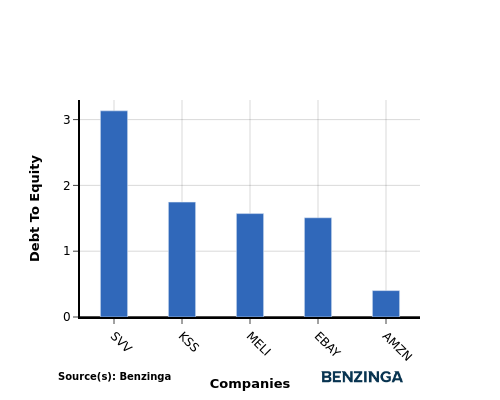Comparing Amazon.com With Industry Competitors In Broadline Retail Industry
Author: Benzinga Insights | October 16, 2025 11:00am
Amidst today's fast-paced and highly competitive business environment, it is crucial for investors and industry enthusiasts to conduct comprehensive company evaluations. In this article, we will delve into an extensive industry comparison, evaluating Amazon.com (NASDAQ:AMZN) in comparison to its major competitors within the Broadline Retail industry. By analyzing critical financial metrics, market position, and growth potential, our objective is to provide valuable insights for investors and offer a deeper understanding of company's performance in the industry.
Amazon.com Background
Amazon is the leading online retailer and marketplace for third party sellers. Retail related revenue represents approximately 75% of total, followed by Amazon Web Services' cloud computing, storage, database, and other offerings (15%), advertising services (5% to 10%), and other the remainder. International segments constitute 25% to 30% of Amazon's non-AWS sales, led by Germany, the United Kingdom, and Japan.
| Company |
P/E |
P/B |
P/S |
ROE |
EBITDA (in billions) |
Gross Profit (in billions) |
Revenue Growth |
| Amazon.com Inc |
32.86 |
6.89 |
3.47 |
5.68% |
$36.6 |
$86.89 |
13.33% |
| Alibaba Group Holding Ltd |
19.18 |
2.71 |
2.84 |
4.26% |
$53.52 |
$111.22 |
1.82% |
| PDD Holdings Inc |
13.76 |
3.57 |
3.29 |
8.89% |
$25.79 |
$58.13 |
7.14% |
| MercadoLibre Inc |
50.59 |
18.18 |
4.31 |
9.76% |
$0.95 |
$3.09 |
33.85% |
| Sea Ltd |
84.24 |
10 |
5.25 |
4.36% |
$0.58 |
$2.41 |
38.16% |
| Coupang Inc |
157.75 |
12.28 |
1.81 |
0.71% |
$0.34 |
$2.56 |
16.4% |
| JD.com Inc |
9.25 |
1.47 |
0.28 |
2.68% |
$7.34 |
$56.64 |
22.4% |
| eBay Inc |
20.19 |
8.74 |
4.17 |
7.59% |
$0.65 |
$1.95 |
6.14% |
| Vipshop Holdings Ltd |
10 |
1.66 |
0.65 |
3.74% |
$1.91 |
$6.05 |
-3.98% |
| Dillard's Inc |
16.59 |
4.89 |
1.45 |
3.86% |
$0.14 |
$0.58 |
1.41% |
| Ollie's Bargain Outlet Holdings Inc |
36.51 |
4.32 |
3.19 |
3.49% |
$0.09 |
$0.27 |
17.49% |
| MINISO Group Holding Ltd |
21.45 |
4.55 |
2.70 |
4.56% |
$0.73 |
$2.2 |
23.07% |
| Macy's Inc |
10.17 |
1.08 |
0.22 |
1.95% |
$0.36 |
$2.1 |
-1.9% |
| Savers Value Village Inc |
65.80 |
4.83 |
1.37 |
4.52% |
$0.06 |
$0.23 |
7.9% |
| Kohl's Corp |
8.25 |
0.44 |
0.11 |
3.97% |
$0.45 |
$1.53 |
-4.98% |
| Hour Loop Inc |
76 |
11.20 |
0.58 |
18.14% |
$0.0 |
$0.02 |
-3.45% |
| Average |
39.98 |
5.99 |
2.15 |
5.5% |
$6.19 |
$16.6 |
10.76% |
By conducting a comprehensive analysis of Amazon.com, the following trends become evident:
-
At 32.86, the stock's Price to Earnings ratio is 0.82x less than the industry average, suggesting favorable growth potential.
-
It could be trading at a premium in relation to its book value, as indicated by its Price to Book ratio of 6.89 which exceeds the industry average by 1.15x.
-
The Price to Sales ratio of 3.47, which is 1.61x the industry average, suggests the stock could potentially be overvalued in relation to its sales performance compared to its peers.
-
The company has a higher Return on Equity (ROE) of 5.68%, which is 0.18% above the industry average. This suggests efficient use of equity to generate profits and demonstrates profitability and growth potential.
-
Compared to its industry, the company has higher Earnings Before Interest, Taxes, Depreciation, and Amortization (EBITDA) of $36.6 Billion, which is 5.91x above the industry average, indicating stronger profitability and robust cash flow generation.
-
The gross profit of $86.89 Billion is 5.23x above that of its industry, highlighting stronger profitability and higher earnings from its core operations.
-
The company's revenue growth of 13.33% exceeds the industry average of 10.76%, indicating strong sales performance and market outperformance.
Debt To Equity Ratio

The debt-to-equity (D/E) ratio assesses the extent to which a company relies on borrowed funds compared to its equity.
Considering the debt-to-equity ratio in industry comparisons allows for a concise evaluation of a company's financial health and risk profile, aiding in informed decision-making.
When evaluating Amazon.com alongside its top 4 peers in terms of the Debt-to-Equity ratio, the following insights arise:
-
Amazon.com is in a relatively stronger financial position compared to its top 4 peers, as evidenced by its lower debt-to-equity ratio of 0.4.
-
This implies that the company relies less on debt financing and has a more favorable balance between debt and equity.
Key Takeaways
For Amazon.com, the PE ratio is low compared to its peers in the Broadline Retail industry, indicating potential undervaluation. The high PB and PS ratios suggest that the market values Amazon.com's assets and sales highly. Amazon.com's high ROE, EBITDA, gross profit, and revenue growth reflect strong financial performance relative to industry peers, highlighting its profitability and growth potential.
This article was generated by Benzinga's automated content engine and reviewed by an editor.
Posted In: AMZN





